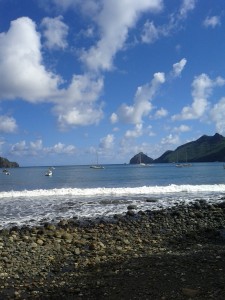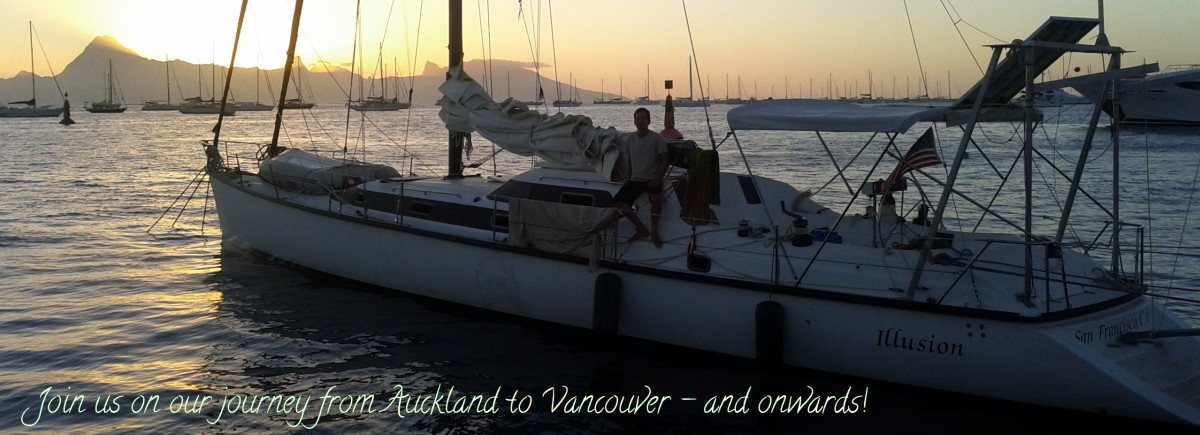I’m about to head back to Hawaii to spend a few days working on Illusion – and maybe get a little winter sunshine, too! This time there’ll be no sailing of course – without an engine it’s too much effort to get in and out of the marina – but heading back to the boat has had me contemplating those last couple of weeks when I was sailing up to Hawaii from Nuku Hiva. Arriving back to Vancouver I was exhausted; a friend recently used the word “depleted” which is a pretty good description. The first few weeks back were a bit of a blur: it was great to see everyone at the ‘Welcome Home’ party (thanks to all who came and gave me such a warm welcome), but somewhat overwhelming to be surrounded by so much noise and activity after all that solitary time and seven months living on the boat, most of them without a whole lot of sleep! I wrote a bit about some of my experiences at sea alone, but I thought it might be interesting, especially for those who have never done long passages, to have an idea of the kinds of things that need to be done and thought about whilst under way. It’s all relevant to group sailing too, but just a little more intense when there’s just one of you… Continue reading “Solo Sailing: Routines”
Category: Doug’s posts
Solo sailing: a day in the life
 In the past I’ve done quite a lot of solo sailing on Illusion, starting in my first years of ownership, sailing into San Francisco’s inland waterways (1000 miles of diked paths snaking through California’s central valley), then later coastal cruising around New Zealand. But this voyage – from Nuku Hiva (in the Marquesas of French Polynesia) to Hawaii – was my first open-ocean passage alone. Usually I set an anchor each night – this was different: 15 days with no anchoring; two weeks out of reach of land. It sounds dramatic, perhaps, but in other ways it was very similar to previous sailing experiences. And as I was alone on the boat, I didn’t feel the same responsibility or concern for how the others were doing. I could make decisions solely based on my needs. If anyone was going to be sick or get injured or break something, it would be me…
In the past I’ve done quite a lot of solo sailing on Illusion, starting in my first years of ownership, sailing into San Francisco’s inland waterways (1000 miles of diked paths snaking through California’s central valley), then later coastal cruising around New Zealand. But this voyage – from Nuku Hiva (in the Marquesas of French Polynesia) to Hawaii – was my first open-ocean passage alone. Usually I set an anchor each night – this was different: 15 days with no anchoring; two weeks out of reach of land. It sounds dramatic, perhaps, but in other ways it was very similar to previous sailing experiences. And as I was alone on the boat, I didn’t feel the same responsibility or concern for how the others were doing. I could make decisions solely based on my needs. If anyone was going to be sick or get injured or break something, it would be me…
As with most ocean crossings, the days were filled with sky and sea, brief radio check-ins, getting food and trying to get sleep. There are plenty of ocean-crossing sailors who describe it as boring. I wouldn’t say that, but there aren’t necessarily lots of anecdotes to come out of it! The first day proved to be the most action packed so it gives an idea of a busy day at sea:
DHL – The Shetland Pony Express of the South Seas
What’s a pony doing on the ocean?!?!? Well, not much, as it turns out. I ordered a replacement motor for the autopilot drive through eBay (another nightmare, worthy of its own post if I ever get round to it) just before we left Tahiti. I contacted the seller in England to confirm that he could ship to French Polynesia and the shipping cost. He said it would take a week for him to order the part, then the DHL “Express” shipment (GBP 50, about US$80) would take 2-5 days.
Continue reading “DHL – The Shetland Pony Express of the South Seas”
Soldering on: 240 Volt Day
I know of three types of mains voltage systems in the world: 100 Volts (Japan) and the 110-120 and 240-250 Volt systems (the Americas, China and a few other countries use the former, European countries and their former dependents use the latter). Illusion was built in the US and so endowed with a 120v system with American sockets. When I settled in New Zealand (a former British colony), I began Illusion‘s partial conversion to 240v…
Engineless
I am still surprised by the confusion that emanates from others when I mention that we’ll be departing their island soon. Of course, they know that Illusion‘s main engine is not functional, so that helps to explain it – I tell them that we’ll sail to the next island. It is a sailboat…
Continue reading “Engineless”
Glow Plugs: A success story
Starting a diesel engine can be a challenging process. As I mentioned in Engine Drama, running a diesel engine is rather simple: fuel, lubrication and cooling. Starting is another matter. Since diesels run without electricity (no spark plugs), the fuel is ignited by heating the air inside the cylinder. Much of this heat is provided by compressing the air when the piston moves up the cylinder – a simple thermodynamic process (it’s the opposite of letting a gas out of a cylinder: like dive or propane tanks, whipped cream cartridges, etc. – high to low pressure transitions chill the gas). To achieve this, diesel engines have significantly higher compression than standard gasoline engines.
My engine also has an intercooler, which transfers some of the exhaust heat into the intake air, boosting the efficiency of the engine (higher combustion temperatures cause more complete fuel burning). Heat in the cylinder walls and pistons (from previous combustion cycles) helps the process, too. But these processes can’t help start a cold engine. Enter the lowly glow plug…
Engine Drama: The day it all went horribly wrong!
For anyone who’s followed this journey for even a little while, they’ve probably already heard many references to our engine failure. I wanted to write about it in some detail, but it’s a long story so I’ve broken it into parts. This post is about the turning point where I stop trying to fix the engine and decide this is going to be an engineless journey.
Continue reading “Engine Drama: The day it all went horribly wrong!”
Engine trouble: the background
For anyone who’s followed this journey for even a little while, they’ve probably already heard many references to our engine failure. I wanted to write about it in some detail, but it’s a long story so I’ve broken it into parts. This post is more about the details of our main engine problems, and so is a bit more technical, but hopefully not as tedious to read as it has been to experience it…
The story starts before we knew the engine was going to die. There was a period of relative calm in the Southern Ocean between New Zealand and Rapa, when we were running the engine to charge the batteries and make slightly better progress. We noticed the exhaust had some black smoke; since the wind was slight and from behind us, the smell wafted over the boat, too. I thought the turbo might be dying, since it has been sitting, rusting externally, for a few years. But the turbo turned out not to be the biggest problem.
Above all else, it’s the Wind…
Everyone talks about the wind here in Rapa. There are few places one can go to get away from it. Today a few of us went on a walk into a valley facing west, looking out onto the “Pacific” (anything but pacified around Rapa) towards New Zealand – a world of experiences away now, even though we departed less than 2 months ago. Walking in a stream in this valley, I suddenly became aware that the sound of the wind was not with us. That ever constant, gale-force roaring had dissipated and I could hear only the gurgling of water pouring down its rocky bed.
Continue reading “Above all else, it’s the Wind…”
Trauma in the Night – Rapa style
The engines (both main yacht and dinghy’s outboard) have had more trauma than any engine should have in a lifetime. Fortunately, the outboard engine has proven very resilient: the latest survival challenge was to be dumped upside down in the water when the crazy winds here flipped the dinghy over in the middle of the night. We went out only a few minutes later (hard to tell something happened, except the bumping noise of the dinghy against the main hull was slightly different), but we lost everything that wasn’t attached (3 oars, a bailing bucket & sponge). The fuel container was floating a few meters behind the boat, still attached to the engine, which was secured to the dinghy, which was secured by a line and a cable to the main boat. No problem, just flip the dinghy upright in 80+ km/h winds and ~1 meter “seas” — in the anchorage! Absurd. Very few days here have not had high winds and choppy waters. This is not a normal South Sea anchorage. Even now it’s howling outside, but the winds have settled down to about 50km/h; gusting as I write this to 65! The Rapans have a legend about not cursing the wind…
Continue reading “Trauma in the Night – Rapa style”
